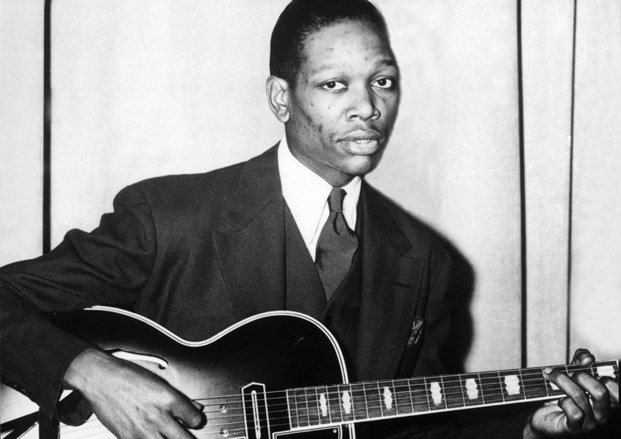Soloing Over Jazz-Blues Chord Changes

In this lesson, I’d like to focus on the art of crafting single-note melodies over the progression in a classic jazz style known as bebop, with ideas inspired by such great composer-improvisers as alto saxophonist Charlie Parker, trumpeter Dizzy Gillespie and guitarists Charlie Christian, Wes Montgomery and Grant Green. Again, we’ll be using the key of G and one of my favorite sets of jazz-blues chord changes, which we’ve been working with in the previous lessons on comping (chord playing).
FIGURE 1 presents two back-to-back 12-bar choruses of soloing, played with a swing feel at a moderately fast tempo. The rhythmic phrasing is primarily eighth notes, but, to add interest and variety, I also use some simpler quarter-note rhythms (see bars 1, 5, 9, 21) and a dotted quarter note (bars 23).
Moving in the opposite direction—meaning subdividing the beat into “smaller, faster” rhythms—I also threw in a couple of eighth-note triplets (bars 9 and 22), a pair of 16th notes (bar 4) and a quick 16th-note triplet (bar 18), all of which are signature bebop-style rhythmic motifs and also serve, along with the occasional rests, in bars 1, 2, 5, 14, 19 and 21, to propel the groove forward while allowing it to breathe and breaking up the monotony and predictability of long, unbroken strings of eighth notes. It is these kinds of little rhythmic variations that help make a melody sound more musical, conversational and sing-able.
Of equal importance is the shape, or contour, of the lines, meaning the ways in which the melody goes up or down and changes direction, which creates its own natural accent pattern, or “rhythm within a rhythm.” The goal should be to strive to sound fresh and avoid falling into a predictable “sing-song” phrasing habit (as we discussed in last month’s lesson on horn section-style comping).
In terms of technique, I’m primarily employing alternate picking here, using my own idiosyncratic approach of mostly picking upstrokes on the downbeats and downstrokes on the upbeats, which is the opposite of what most guitar players do and is just the way my jazz soloing style developed. (Sorry, if this way of playing is alien to you!) I do use a little bit of legato technique here and there, such as the occasional hammer-on, pull-off and finger slide, to help vary the phrasing and soften the note attack. I also perform a couple of bends and vibratos, which I employ as decorative elements, in an effort to impart a bluesy touch to the solo.
You’ll notice that most of the lines are built from arpeggios, with the emphasis on outlining each chord change by landing on a chord tone, such as the root, third, fifth, seventh, ninth or 11th. I also employ both chromatic and diatonic (scale-based) passing tones, which serve as transition notes that smoothly connect the targeted chord tones.
String Theory November 2016 FIGURE 1
All the latest guitar news, interviews, lessons, reviews, deals and more, direct to your inbox!

Over the past 30 years, Jimmy Brown has built a reputation as one of the world's finest music educators, through his work as a transcriber and Senior Music Editor for Guitar World magazine and Lessons Editor for its sister publication, Guitar Player. In addition to these roles, Jimmy is also a busy working musician, performing regularly in the greater New York City area. Jimmy earned a Bachelor of Music degree in Jazz Studies and Performance and Music Management from William Paterson University in 1989. He is also an experienced private guitar teacher and an accomplished writer.

